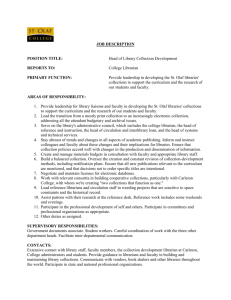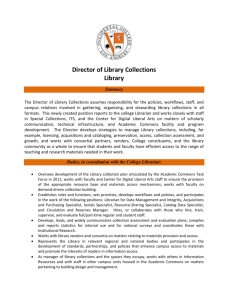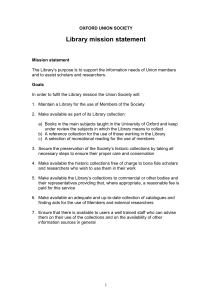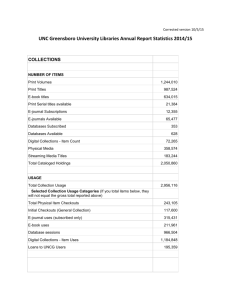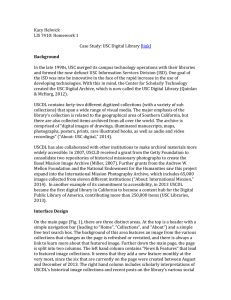Developing Outstanding Core Collection
advertisement
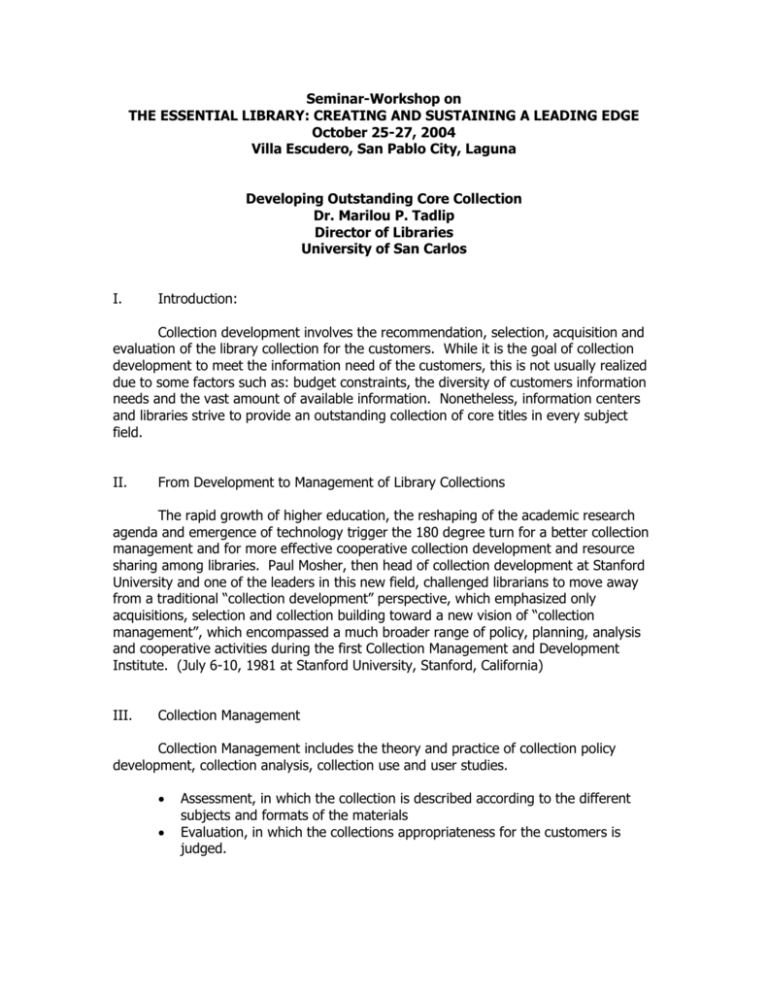
Seminar-Workshop on THE ESSENTIAL LIBRARY: CREATING AND SUSTAINING A LEADING EDGE October 25-27, 2004 Villa Escudero, San Pablo City, Laguna Developing Outstanding Core Collection Dr. Marilou P. Tadlip Director of Libraries University of San Carlos I. Introduction: Collection development involves the recommendation, selection, acquisition and evaluation of the library collection for the customers. While it is the goal of collection development to meet the information need of the customers, this is not usually realized due to some factors such as: budget constraints, the diversity of customers information needs and the vast amount of available information. Nonetheless, information centers and libraries strive to provide an outstanding collection of core titles in every subject field. II. From Development to Management of Library Collections The rapid growth of higher education, the reshaping of the academic research agenda and emergence of technology trigger the 180 degree turn for a better collection management and for more effective cooperative collection development and resource sharing among libraries. Paul Mosher, then head of collection development at Stanford University and one of the leaders in this new field, challenged librarians to move away from a traditional “collection development” perspective, which emphasized only acquisitions, selection and collection building toward a new vision of “collection management”, which encompassed a much broader range of policy, planning, analysis and cooperative activities during the first Collection Management and Development Institute. (July 6-10, 1981 at Stanford University, Stanford, California) III. Collection Management Collection Management includes the theory and practice of collection policy development, collection analysis, collection use and user studies. Assessment, in which the collection is described according to the different subjects and formats of the materials Evaluation, in which the collections appropriateness for the customers is judged. Environmental San for Collection Development, critical issues 1. Access vs. ownership debate Decisions in the past were made for a printed based environment Consideration for various resource sharing arrangements Today’s decision considers the need for computer infrastructure support for electronic access 2. Restricted Materials Budget Information explosion Users want everything 3. Changing management strategies to maximize budgets Downsizing of staff Merger of departments or positions Use of outsourcing of cataloging functions for gains of efficiency and cost Greater reliance on external funding Continuous improvement (CI) programs for customer satisfaction 4. Impact of information technology Changes in library role as provider of information Vast array of information resources New skills and competencies needed for staff Need to evaluate resource sharing opportunities Shifts in Collection Resources 1. Availability of a wealth of information resources The array of resources offer users a lot o choices as they enter online catalogs and other information resources Choices can be overwhelming and confusing 2. Cooperative collection development and resource sharing takes on new meaning Providing access in a digital format in addition to the traditional activities of selecting, cataloging and providing bibliographic access 3. Development of Internet tools, World Wide Web Access and Online Multimedia capabilities enables access to collections regardless of format or location Approaches to managing information (refer to diagram) 2 mptadlip, usc/October 2004 Approaches to Management Information IV. Models developed by AAU/ARL Taskforce on a National Strategy for Managing Scientific and Technological Information Models characterize the shift in collection development approaches and the shift in collection cost from building tangible collections to cost of DATA TRANSFER with nothing tangible retained by the library Implications to collection development are: 1. University and library funding for information infrastructure is critical 2. Electronic resources are varied and complex; need to be chosen well and properly evaluated for appropriateness to needs 3. Computer infrastructure system need to be stable at all times for access Collection Evaluation: 4.1 How Collections are Measured: Evaluation and assessment techniques fall into two broad categories: Collection-centered (counting holdings and checking lists to determine the collection’s scope and depth) Client-centered (conducting user surveys and gathering information on how clients use the collection) An effective assessment uses both types of techniques to gather two types of data: Quantitative (including numbers, age and/or use of statistics) Ex: Number of titles: A manual or automated shelf list count, a physical count or estimate of titles from the shelves, a count of acquisitions and expenditures, the percent of each subject’s yearly growth, the percent of acquisitions compared to published titles. Use: Circulation statistics by type of subject and interlibrary loan borrowing statistics Qualitative (such as observations) Ex: Percent of standard titles or items: Calculated by consulting “best” lists Individual or group evaluation: Shelf scanning by the librarian, observation by an outside expert or observation by a committee. 3 mptadlip, usc/October 2004 Assessment Techniques: Examination of shelf list data This technique gathers quantitative data about the collection, including number of titles, percent of the total collection, median age and mode. An automated system can often provide detailed reports of this information. Direct examination of the collection List checking This method compares the collection to authoritative lists of what is available and appropriate for a particular type of collection. Evaluation by an outside expert or a specialist on the library staff A knowledgeable person from outside the library staff can be enlisted to survey a portion of the collection and provide qualitative data. (The current trend in large universities abroad is to employ a bibliographer or resource specialist) Citation Analysis This technique is most applicable to research or special collections. It can be characterized as a specialized form of checking, in which the lists are created by the assessor from scholarly books and articles. Bibliographer or Research Manager or Resource Specialist Changing scenario has broadened the roles of the collection specialist Areas of specialty are now broader than just specific programs or departments New specialist of resources must have the ability to work with interdisciplinary programs and resources Some new tasks are: 1. Collection development, evaluation, selection and management of resources; local, networked and remote 2. Development of strategies and software for subject/discipline network access 3. Decision making regarding resource sharing 4. Providing specialized research assistance to users; networked or local 5. Assisting users in the use of databases and electronic resources 6. Development of a resource map to guide selection and evaluation of resource A resource map is an information map on web page to guide users to vast sources including a hot link to the resources specialist 4 mptadlip, usc/October 2004 Assessment Framework: The Conspectus Approach Standardizes definitions, breaks the collection down into subject areas and defines a rating system for acquisition/collection levels and goals. Collection Codes: CL – Current Collection (the current strength of the collection compared to what is available worldwide) AC – Acquisition Commitment (the collection’s current growth rate, including purchases and gifts) GL – Collection Goal (the library’s target level) PC – Preservation Commitment (the library’s commitment to intellectual content The ratings ranges from 0 – 5 0 – Out of Scope (The library does not collect in this subject) 1 – Minimal Level (a subject area which is our scope for the library’s collections, and in which few selections are made beyond very basic reference tools) 2 – Basic Information Level (A highly selective collection which serves to introduce and define the subject and to indicate the varieties of information available elsewhere. It includes major dictionaries and encyclopedias, selected editions of important works, historical surveys, important bibliographies and a few major periodical in the field) 3 – Study or Instructional Support Level (A collection which is adequate to support undergraduate or graduate course work, or sustained independent study; that is, which is adequate to maintain knowledge of a subject required for limited or generalized purposes, of less than research intensity. It includes a wide range of basic monographs, complete collections of the works of more important writers, a selection from the works of secondary writers, a selection of representative journals and the reference tools and fundamental bibliographic apparatus pertaining to the subject.) 4 – Research level (A collection which include the major source materials required for dissertations and independent research, including materials containing research reporting, new findings, scientific experimental results, and other information useful to researchers. It also includes all important reference works and a wide selection of specialized monographs as well as a very extensive collection of journals and major indexing and abstracting services in the field.) 5 mptadlip, usc/October 2004 5 – Comprehensive Level (A collection in which a library endeavors, so far as is reasonably possible, to include all significant works of recorded knowledge (publication, manuscripts, other forms) in all applicable language, for a necessarily defined and limited field. This level of collection intensity is that which maintains a “special collection”, the aim if not the achievement is exhaustiveness) The ratings do not judge the collection as “good” or “bad”. The collection is evaluated by comparing the levels of current collection (CL) and acquisitions commitment (AC) to the collection goal (GL) and preservation commitment (PC). 4.2 Customer Needs Assessment A process that will help determine how well your library is currently meeting the needs of your customers and what other types of resources and services it can provide in the future. Results of a needs assessment study can be used to determine: V. How extensively the collection is being used and to identify gaps Who uses the library and ways to reach non-users How successful library services are and how they can be improved to reflect the customers needs Whether staffing patterns and library hours are adequate. Suggested Ways of Developing Bibliographic Competence in a Subject Area (Capacity Building for Collection Developers) 1. Prepare a topical outline of the subject content. Use general encyclopedia divisions to obtain an overview of the subject. 2. Consult a principal subject encyclopedia. 3. Locate and examine all literature guides. Begin with the card catalog. In examining literature guides, look at the table of contents and index for key concepts of the subject. 4. Prepare a list of basic textbooks and other general works devoted to the whole field. 5. Make a similar study of the books and monographs devoted to a special aspect of the field. 6. Pay special attention to producers of materials like associations, museums, universities, libraries An association brings together key men with their own special talents An association library or university press puts out accessions lists and bibliographies which are often the best selection tools. Example: Women in Literary Arts (WILA), BATHALAD, Lubas sa Dagang Bisaya (LUDABI), Puting Dagang, Historical Association of Cebu (HACE), Cebu Historical Society 6 mptadlip, usc/October 2004 7. Become familiar with periodical and serial publications. 8. Make a thorough study of reference books in the subject area. 9. Learn the trends of reference in the subject by looking at annual reviews and annual reports. 10. Be familiar with kinds of data, materials and methodology in the discipline. 11. Keep up with latest research of the subject area, through abstracts of dissertations VI. Conclusion Up to now, many good librarians will confirm that the measure of a good library is the collection For several reasons, including diminishing budgets, size may no longer be the single most dependable gauge of a library As a result of IT, information gateways other than print sources have made possible access to a vast array of digitized information packages, thus expanding a library’s reach of resources The libraries of the FUTURE will be distinguished not by size and quality of collections alone but by their o Ability to provide network access to resources and o Agility in providing wide access to remote resources The librarian-developer of good core collections must be cognizant of the changing scenario in collection management and must possess the competence and commitment to do the essential paradigm shift. Only then can libraries and librarians maintain and sustain the leading edge. 7 mptadlip, usc/October 2004


